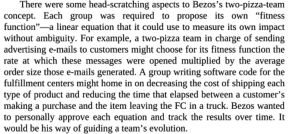For the last couple weeks, I’ve been reading The Everything Store: Jeff Bezos and the Age of Amazon by Brad Stone. The book primarily chronicles the complete history of Amazon, and in parallel, its irascible CEO. I’m really enjoying it so far, especially the nuggets of Amazon management philosophy.
There are all of the expected items that you’ve probably heard about before:
- 2 pizza teams
- Service oriented architecture
- Outlawing powerpoint and making executives write long form proposals
- Writing the press release of a new product before development begins
But one concept that I hadn’t heard before was something called “fitness functions.” At one point in the history of Amazon, Jeff Bezos decided that each of his teams (across all functional areas) should be responsible for developing and publishing an equation that they felt to be indicative of them doing a good job. This fitness function would then be used to evaluate each team’s performance.
Here’s the excerpt (courtesy of Amazon):
Although, according to this Quora post, the method is no longer widely used at Amazon, I thought it was pretty fascinating. It takes some deep thought to develop this kind of equation. The second I read about this concept, I immediately started thinking about how I would write my own fitness function for product management.
Well let’s see – in order to develop a fitness function, first you have to decide which metrics are important to you. What would that be for Product Management?
I think success would be a function of:
- Revenue (of course)
- Customer satisfaction (as measured by a survey, or in absence of a survey, number of support cases)
- Product adoption (as measured by number of clients using products)
- Speed of product development (as measured by delivery against roadmap commits)
Obviously some of these are easier to measure than others.
Then you have to decide relative priority of the variables to put them in the form of an equation.
I think I would put them in this priority order:
- Revenue (30%)
- Product Adoption (although, top tier clients should be given higher weight) (30%)
- Customer Satisfaction (25%)
- Speed of Development (15%)
Now – let’s see if we can put it all together into an equation.
Success of Product Management = ((% Revenue pacing to goal) * 30%) + (((Percent product adoption among top tier clients)* 70%) + ((Percent product adoption among lower tier clients) * 30%))) * 30%) + (Percentage of satisfied customers * 25%) + (Percentage of products shipped on time * 15%)) * 100
Not quite a linear equation, but an equation none-the-less (I found it very difficult to deal with the wildly differing units of measure). Interesting exercise – in my opinion, something every team should think about.
